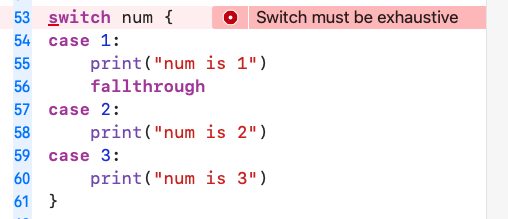if else
while
var num = 5while num > 0 {print("num is \(num)")num -= 1}var num = -1repeat {print("num is \(num)")} while num > 0
repeat-while 相当于C语言中的do-while
这里不是num—,是因为Swift3开始,去除了自增(++)、自减(—)运算符
(阅读性较差)
for
闭区间运算符: a…b,a <= 取值 <= b
let names = ["a", "b", "c", "d"]for i in 0...3 {print(names[i])}
或者 let range = 0…3, for i in range这样遍历
如果没有用到i,可以用下划线代替
for _ in 0...3 {}
半开区间运算符:a..
for name in names[0...3] {print(name)}
单侧区间:让区间朝一个方向尽可能的远
for name in names[...3] {print(name)}for name in names[..<3] {print(name)}
也可以将区间赋值给range
// 负无穷到5let range = ...5range.contains(7) // truerange.contains(3) // false
字符、字符串也能使用区间运算符,但默认不能在for-in中
let range = "a"..."z"range.contains("c")range.contains("e")
带间隔的区间值
/// 打印0-100间的偶数for i in stride(from: 0, through: 100, by: 2) {print(i)}
switch
let num = 1switch num {case 1:print("num is 1")case 2:print("num is 2")case 3:print("num is 3")default:print("num is other")}// num is 1
case、default后面不能写大括号{}
默认可以不写break,并不会贯穿到后面的条件
fallthrough,可以实现贯穿效果
let num = 1switch num {case 1:print("num is 1")fallthroughcase 2:print("num is 2")case 3:print("num is 3")default:print("num is other")}// num is 1// num is 2
switch必须保证能处理所有情况,下面这种情况不写default就会报错
case、default后面至少有一条语句,如果不想做任何事情,加个break即可
如果能保证处理所有情况,也不必使用default,例如枚举
enum Answer {case rightcase wrong}let answer = Answer.rightswitch answer {case .right:print("answer is right ")case .wrong:print("answer is right ")}
复合条件
switch也支持Character、String类型
let string = "Jack"switch string {case "Jack":print("is jack")case "Tom":print("is Tom")default:break}
复合条件可以使用逗号分隔条件,也可以用fallthrough关键字
switch name {case "Jack", "Rose":print("is Jack and Rose")case "Tom":print("is Tom")default:break}switch name {case "Jack":print("is jack")fallthroughcase "Rose":print("is Rose")case "Tom":print("is Tom")default:break}
字符类型也一样:
let c: Character = "a"switch c {case "a":print("is a")case "A":print("is A")defaultbreak}
区间匹配、元组匹配
let count = 62switch count {case 1..<5:print("1..<5")case 6..<100:print("6..<100")default:break}
let point = (1, 1)switch point {case (0, 0):print("is zero point")case (_, 0):print("is on x-axis")case (0, _):print("is on y-axis")default:break}
可以使用下划线忽略某个值,case匹配问题,属于模式匹配(Pattern Matching)的范畴
值绑定
switch point {case (let x, 0):print("x is \(x)")case (0, let y):print("y is \(y)")case let (x, y):print("x is \(x), y is \(y)")default:break}
where
在switch语句中作为条件
switch point {case let (x, y) where x == y:print("x == y")case let (x, y) where x == -y:print("x == -y")default:break}
在for循环中作为条件
// 打印区间内所有的偶数for i in -100...100 where i%2 == 0 {print("i = \(i)")}
标签语句
outer: for i in 0...3 {for k in 0...3 {if k == 3 {continue outer}if i == 3 {break outer}print("i = \(i), k = \(k)")}}

